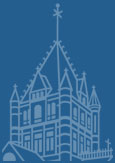
- Trinity Voices
From the Historian: Painting a Picture
Dear Trinity Church and Friends,
In 1728, the same year that merchant Leonard Vassall posted the bond for the purchase of land to build Trinity Church, forty-year-old Scottish born painter John Smibert sailed for America. Smibert accompanied Bishop George Berkeley with the intention of teaching fine art in Bermuda. In the end he stayed in Boston. As a skilled, academically trained artist he prospered as a portraitist. By 1734 he opened a shop providing artists’ supplies including pigments, paintbrushes and mezzotint. His studio, located above the shop, displayed copies of Old Masters that he had painted in Europe as well as original works he had purchased while abroad. This collection, considered by some to be America’s first art gallery, provided artistic inspiration for a generation of painters from Gilbert Stuart to John Singleton Copley.
Did this environment inspire Smibert’s “Negro man servant” Cuffee to apply paint to canvas?
Cuffee formerly belonged to Captain Job Prince “and understood somewhat the business of a sailor,” according to Smibert’s 1737 runaway slave advertisement. He was 22 years old, “spoke good English and was pretty tall and well-shaped with bushy hair. He wore a large dark colored jacket, a pair of leather breeches stained with diverse sorts of paints, and a pair of blue stockings. Whoever shall take up said Runaway, and him safely convey to his Master in Boston shall have three pounds reward …”
By the time Cuffee ran away, Trinity Church had been offering services in its new, if not quite finished, building for two years. It is unclear if Smibert and his family ever attended. But Smibert may have produced a painting for the church. If true, it must have been a fairly large canvas. The four angel head paintings, or cherubs, hanging on the wall of the Angel Room in the Parish House have historically been attributed to him. They were supposedly cut from a canvas that hung in that first building on Summer Street.
Smibert’s portfolio includes the portraits of Boston’s business and social elites. In 1742 he painted Peter Faneuil and would also design the first Faneuil Hall. Smibert died in 1751. We do not know if Cuffee, with his paint splotched pants, ever returned to Smibert. We do know that upon Smibert’s death he owned a “Negro girl Phillis.” Listed in the estate inventory of property, she was valued at 26 pounds.
No probate records exist for painter Prince Demah. He was baptized at Trinity in 1745 with his mother Dafney/Daphney. Church records indicate that he died in 1778. During those intervening years, he and his mother were purchased by distiller Henry Barnes and his wife Christian. They recognized Prince’s aptitude for art and chose to nurture it. Henry took the child with him to London in 1770 where one year later he was receiving lessons from British portrait painter Robert Edge Pine. Henry supported Prince’s education but he kept the boy close so that he would not be corrupted by the rhetoric of Britain’s black and white abolitionist leaders. Once back in Boston, Christian wrote to friends of Prince’s skill that she thought might rival Copley’s.
Prince did paint portraits including portraits of Henry and Christian Barnes. On one of his three surviving paintings he signed, “Prince Demah Barnes.” He is considered the only known enslaved artist working in colonial America whose works have survived.
The Barnes were Loyalists. In 1775, they fled to England, leaving Prince behind. In 1777 he enlisted in the Massachusetts militia identifying himself as “Prince Demah,” dropping the Barnes surname. He died the following year. In his will, he described himself as “Prince Demah of Boston,” a painter of portraits and “a free Negro.” He left all of his possessions to his mother.
Portraitists are known for painting pictures of themselves. Smibert was no exception. For instance, he skillfully inserted himself into one of his most famous paintings, The Bermuda Group. Did Prince Demah ever paint himself or his mother? We’ll never know. We can only imagine.
Until next month,
Cynthia Staples
Sources
New England Weekly Journal October 25, 1737
Suffolk County Probated Will of John Smibert, 1752
Encyclopaedia Britannica Entry, John Smibert, 1911
https://outofthearchives.org/2015/01/10/prince-demah-portrait-painter/
The Records of Trinity Church Boston, 1728-1830
- December 2022
- November 2022
- June 2022
- February 2022
- January 2022
- November 2021
- October 2021
- September 2021
- August 2021
- July 2021
- June 2021
- May 2021
- April 2021
- March 2021
- February 2021
- January 2021
- December 2020
- November 2020
- October 2020
- September 2020
- August 2020
- July 2020
- June 2020
- May 2020
- April 2020
- March 2020


Comments